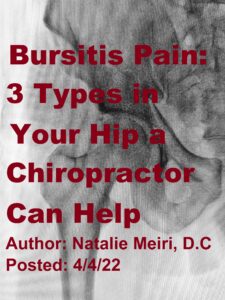
This post is about bursitis pain: 3 types in your hip a chiropractor can help. You may have had a fall onto the hip? Perhaps you have thigh pain from a sudden movement? Moreover as a weight bearing joint, the hip is commonly affected by degenerative joint changes and soft tissue damage. So you may think your pain is in the low back or buttocks when it is in fact due to your hip!
Hip Anatomy:
The hip, like the shoulder, is considered a ball-and-socket joint. It is formed by the head of the femur (thigh bone) which sits in what’s called the acetabulum, a part of the pelvis. The head of the femur is large (ball) and the acetabulum (socket) is deep. The soft tissues (refers to non-bony structures that connect, support, or surround other structures) in your hip are:
- the muscles, which allow you to move.
- the tendons, which connect your muscles to the bone.
- the ligaments are bands of tough elastic tissue around your joints. They connect bone to bone, give your joints support, and limit their movement.
- the fascia – stretchy, thin, white fibrous tissue. All our muscles are enveloped in fascia.
- the bursae – fluid-filled pads that act as cushions at the joints. Bursae reduce friction between the surfaces of a bone and soft tissue.
This post is about Bursitis Pain: 3 in your Hip a Chiropractor Can Help with. Bursitis is inflammation of a bursa. There are many causes of bursitis.
-
Subtrochanteric Bursitis
Several bursae in your hip are capable of producing symptoms in the subtrochanteric region (top of thigh bone). There are 3 in the gluteal (buttock) region: your subgluteus medius, subgluteus maximus, and the gluteus minimus bursae.
Subtrochanteric bursitis occurs between the ages of 40 and 60 years of age. Repetitive activity can be a major cause in all ages. This is because the repetitive friction over the bursa causes it to be inflamed. In runners, it maybe caused by the running technique and surface. For instance, running on both banked surfaces and allowing the feet to cross the midline when running could be culprits.
You may have well-localized lateral (side) hip pain. It may cause you to limp mildly. Sometimes subtrochanteric bursitis may cause pain radiating to the low back, the lateral thigh, and the knee. And you will not be able to lay on the involved side.
Cause
Anything that leads to altered hip mechanics/motion, including low pack pain, leg length discrepancy, arthritic conditions, post-surgery, and neurologic conditions, may cause subtrochanteric bursitis.

-
Iliopectineal and Iliopsoas Bursitis
Iliopsoas or illiopectineal bursitis is an inflammation of the bursa located beneath the iliopsoas muscle. This muscle is partly located in front of the hip where the bursa is. You will have a severe, acute anterior (nearer the front) hip pain with an antalgic gait. Antalgia is an unnatural position or movement assumed by someone to minimize or alleviate pain or discomfort. For example, you may have your hip flexed and externally (outward) rotated to relieve pain. You may also have pain radiating down the anterior (front) aspect of the leg. This is due to pressure on the neighboring femoral nerve.
Cause
These anterior bursitises are possibly due to hip flexor (muscles that help you move your leg and knee up towards your body) tightness along with repetitive activity.
-
Ischial Bursitis
The ischial bursa are located under the hamstring and the base of the pelvis. You may have pain referral down the back of the leg mimicking sciatica. Interestingly, you may notice that pressing the foot down on the brake pedal (or gas pedal) of a car may relieve the pain! In the younger athletic patient, speed work (sprinting) may cause this bursitis due to excessive hamstring contraction (use).
Cause
Ischial bursitis can be caused by a direct traumatic blow to the bursa. Also, it often occurs after sitting for long periods of time on hard surfaces (benchwarmer’s bursitis) or during horseback riding. Chronic hamstring strains and occasionally prolonged standing may also cause irritation to this bursae.
Padding such as a small inflatable pillow for sitting may help.

Treatment at Meiri Chiropractic for Bursitis: 3 in your Hip a Chiropractor Can Help
Treatment focuses on restoring normal mobility to the hip joint and pelvis. These treatments at Meiri Chiropractic include:
-Chiropractic manipulative therapy to the hip joint, pelvis and associated regions.
-Gentle myofascial release and/or post isometric relaxation techniques to the soft tissues involved.
-Electric Muscle Stimulation, Ice and Heat Therapies for pain relief and inflammation reduction.
Finally, recommendations for prevention of further injury at the pelvis, hip and thigh. This involves a routine of stretching and warming up prior to activity.
Getting regular chiropractic care from a West Palm Beach hip pain chiropractor can give relief naturally from an already existing injury, or even offer injury prevention. Chiropractic is a holistic and natural way to treat existing injuries and to keep your body in its best working condition.
Contact Meiri Chiropractic today at 561-253-8984 on Bursitis: 3 in your Hip a Chiropractor Can Help or/and other ailments.
References:
Thomas Bergman, David Peterson, Chiropractic Technique Principles and Procedures, 3rd edition, 2011